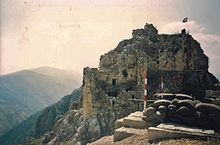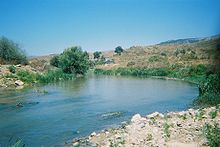Litani River
| Litani River | |
|---|---|
 | |
 The Litani River in maroon, the Lebanese capital city Beirut in red | |
| Location | |
| Country | Lebanon |
| Physical characteristics | |
| Mouth | Mediterranean Sea |
 | |

The Litani River (Arabic: نهر الليطاني, romanized: Nahr al-Līṭānī), the classical Leontes (‹See Tfd›Greek: Λεόντης, translit. Leóntes, lit. "lion river"), is an important water resource in southern Lebanon. The river rises in the fertile Beqaa Valley, west of Baalbek, and empties into the Mediterranean Sea north of Tyre. Exceeding 140 km in length, the Litani is the longest river that flows entirely in Lebanon and provides an average annual flow estimated at 920 million cubic meters.[1][2] The Litani provides a major source for water supply, irrigation and hydroelectricity both within Southern Lebanon, and the country as a whole.
Etymology
[edit]The Litani is named after the Ugaritic deity Ltn (reconstructed pronunciation līyitānu[3]), a seven-headed sea serpent and servant of the sea god Yam.[4] The ī in the Lebanese name preserves the hypothesized ī in Ugaritic. The river that winds and coils like a serpent through the Beqaa Valley was believed[by whom?] to be the personification of the deity.[5]
History
[edit]
Historians in the past have suggested that the location of Biblical Misrephoth Maim, the place to which Joshua chased the various tribes after their defeat at the waters of Merom, was the river-mouth of the Litani River. [6]
Geography
[edit]
The Litani River, stretching 174 km with 60 km of tributaries, traverses diverse climates from coastal subtropical to dry continental. Its basin encompasses 2110 km2, making it the largest watershed in Lebanon and covering about 20% of the country's total area. The basin spans 263 villages in 12 districts and 4 governorates, covering a significant portion of Lebanon's ecological landscape and contributing around 30% of the total water flow in the country.[7]
Within the basin of the Litani River, there are notable natural features, including Kafr Zabad (60 ha), characterized by marshland, constant springs, riparian woodland, and pine woodlands. The Aammiq wetlands (280 ha), designated a World Nature Reserve, serves as an important point in global bird migration routes, hosting nearly 250 bird species. The Al Shouf Cedar Nature Reserve (55,000 ha), with its eastern section falling within the basin, contributes to the conservation of Lebanese cedars.[7]
After heading south parallel to the Syrian border, the course of the river bends westward. Near this bend, the Litani comes within five km of the Hasbani River.
Qasimiyeh
[edit]The portion of the river flowing west is called the Qasimiyeh. The Qasmieh-Ras-el-Aïn region, irrigated from the river's lower reaches from main irrigation canals, to south and north, is one of the largest irrigated areas in the nation, consisting of 32.64 km², shared among 1257 irrigating farmers, who concentrate on citrus crops and bananas (Raad 2004).
For the entire stretch of the Qasimiyeh as it flows into the Mediterranean Sea, the Litani River remains nearly parallel to (and about 29 km (18 mi) north of) the Israeli-Lebanese border. 10 km north of Tyre, the river is crossed by the ancient Leontes Bridge. In June 1941, the mouth of the river was the site of an attack by British commandos and Australian troops on Vichy French forces that became known as the Battle of the Litani River.
Bridges over the Litani
[edit](Jisr means bridge in Arabic)
- Jisr el-Kasmieh/Qasimiyeh (Roman Leontes Bridge); in ruins
- Jisr el Akai
- Jisr el-Khardali
- Jisr el-Khatueh (Kakhieh)
- Jisr el-Burghuz
- Jisr el-Meshghara
- Jisr el-Karaoum
Litani River Dam
[edit]
Lake Qaraoun, an artificial lake of 12 square km, was created by the Litani River Dam, 60 meters high and 1,350 meters in length, which was completed in 1959.[8] A spillway of 6503 meters carries the water to the underground station where generators produce a maximum of 185 megawatts of electricity, the largest hydroelectric project in Lebanon. The dam was intended eventually to provide irrigation for 310 km² of farmland in South Lebanon and 80 km² in the Beqaa Valley. The office is at the southern (dam) end of the lake on the left side.
The Litani River Authority
[edit]The Litani River Authority[9] was formed in 1954 to facilitate the integrated development of the Litani River Basin. Shortly after its formation, the authority engaged in a massive hydroelectric development project[9] that tapped the 850 meter head potential between Lake Qaraoun and the Mediterranean.
This development has brought about major hydrological changes to the Litani River Basin, where the flows from its upper reaches above Lake Qaraoun, referred to as the Upper Litani Basin, are diverted through a system of tunnels, ponds and plants, to meet the Mediterranean several kilometers north of its original natural tailwater. These changes resulted in the effective hydrological separation between the Upper Litani Basin and the lower reaches.
The advent of a protracted civil strife in the 1970s followed by a prolonged occupation in the 1980s that lasted into the 1990s, plunged Lebanon into disarray, freezing development and investment in infrastructure. The return to normal conditions has encouraged the river authority to initiate several major water diversion projects from the Upper Litani Basin worth hundreds of millions of US dollars.
Agriculture
[edit]A crucial aspect of the Litani River's importance lies in its role as an agricultural lifeline. It irrigates thousands of hectares of farmland, contributing significantly to Lebanon's food security. Approximately 31% of the income within the basin stems from agriculture, sustaining a considerable portion of the population.[10]
Pollution
[edit]The Litani River contends with pollution concerns, impacting both the river itself and the Qaraaoun Reservoir. Numerous studies, including microbiological and chemical analyses, revealed contamination exceeding standard levels. The root causes include uncontrolled sewage disposal and the indiscriminate use of fertilizers in agriculture, threatening both water quality and the health of the river.[11]
See also
[edit]- Battle of the Litani River (1941), during the Second World War, between Allied forces and Vichy French troops
- Operation Litani, 1978 Israeli invasion of Southern Lebanon
Citations
[edit]- ^ "LEBANON, Water resources". FAO UN. Archived from the original on 6 June 2015. Retrieved 4 November 2019.
- ^ "The Characteristics of the Litani River". The Litani River Authority. Archived from the original on 5 October 2018. Retrieved 4 November 2019.
- ^ Emerton, J. A. (1982). "Leviathan and LTN: The Vocalization of the Ugaritic Word for the Dragon" (PDF). Vetus Testamentum. 32 (3): 327–331. doi:10.1163/156853382X00324. JSTOR 1517920.
- ^ Price, Robert. Bart Ehrman Interpreted. Pitchstone Publishing, Durham, NC. 2018, p. 153.
- ^ Price (2018), p. [1].
- ^ van Bekkum, Koert van (2011). From Conquest to Coexistence: Ideology and Antiquarian Intent in the Historiography of Israel's Settlement in Canaan. Koninklijke Brill NV, Leiden, The Netherlands, p. 178.
- ^ a b Abd El Al, Iman (2018). "Historical Background on the Litani River". In Shaban, Amin; Hamzé, Mouïn (eds.). The Litani River, Lebanon: an assessment and current challenges. Water science and technology library. Cham: Springer. pp. 15–32. ISBN 978-3-319-76300-2.
- ^ "The Qaraoun Dam". The Litani River Authority. Archived from the original on 28 March 2019. Retrieved 4 November 2019.
- ^ a b "Litani River Basin Management Support Project (LRBMS)". Globalwaters. Archived from the original on 4 November 2019. Retrieved 4 November 2019.
- ^ Shaban, Amin; Hamzé, Mouïn, eds. (2018). The Litani River, Lebanon: an assessment and current challenges. Water science and technology library. Cham: Springer. pp. 15–32. ISBN 978-3-319-76300-2.
- ^ Shaban, Amin; Hamzé, Mouïn, eds. (2018). The Litani River, Lebanon: an assessment and current challenges. Water science and technology library. Cham: Springer. pp. 1–15. ISBN 978-3-319-76300-2.
General and cited references
[edit]- Ramadan, H. H., Beighley, R. E. and Ramamurthy, A. S. (2013). "Temperature and precipitation trends in Lebanon's largest river: the Litani Basin”, American Society of Civil Engineers, Journal of Water Resources Planning and Management, 139 (1), pp. 86–95.
- Ramadan, H.H., Ramamurthy, A.S., and Beighley, R.E (2012). "Inter-annual temperature and precipitation variations over the Litani Basin in response to atmospheric circulation patterns”, Theoretical and Applied Climatology, Volume 108, Numbers 3-4 (2012), pp. 563–577.
- Ramadan, H.H., Beighley R.E. and Ramamurthy A.S. (2012). "Modeling Streamflow Trends for a Watershed with Limited Data: A case on the Litani Basin, Lebanon” Hydrological Sciences Journal, 57 (8), pp. 1516–1529.
- Ramadan, H.H., Ramamurthy A.S. and Beighley R.E. (2013). "Sensitivity of the Litani Basin’s runoff in Lebanon to climate change.” International Journal of Environment and Pollution (in press).
- Bregman, Ahron (2002). Israel's Wars: A History Since 1947. London: Routledge. ISBN 0-415-28716-2
- Raad, Daoud, 2004. "Localized irrigation in Qasmieh-Ras-el-Aïn: a technique to be encouraged" pdf file
- Amery, H. A. 1993. "The Litani River of Lebanon", Geographical Review 83 (3) pp229–237.
- Where the western Litani empties into the Mediterranean, on Wikimapia
- Old Feud Over Lebanese River Takes New Turn
- Assaf, Hamed and Saadeh, Mark. "Development of an Integrated Decision Support System for Water Quality Control in the Upper Litani Basin, Lebanon", Proceedings of the iEMSs Third Biennial Meeting, "Summit on Environmental Modelling and Software". International Environmental Modelling and Software Society, Burlington, USA, July 2006.
- Price, Robert M. (24 April 2018). Bart Ehrman Interpreted. Pitchstone Publishing (US&CA). ISBN 978-1-63431-159-5.
External links
[edit]- HUSSEIN A. AMERY. "THE LITANI RIVER OF LEBANON". macam. Archived from the original on 28 July 2019. Retrieved 4 November 2019.
- Lebanese minister: Litani river pollution a "national catastrophe" Archived
